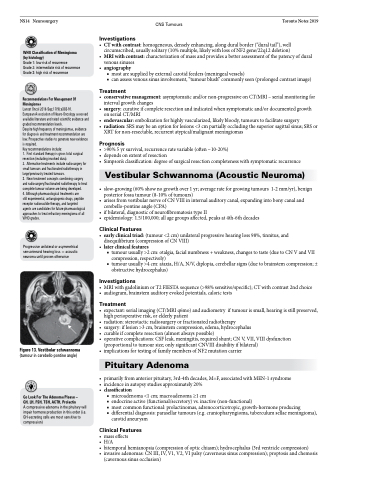Page 812 - TNFlipTest
P. 812
NS14 Neurosurgery
CNS Tumours Toronto Notes 2019
WHO Classification of Meningioma (by histology)
Grade 1: low risk of recurrence
Grade 2: intermediate risk of recurrence Grade 3: high risk of recurrence
Recommendations For Management Of Meningiomas
Lancet Oncol 2016 Sep;17(9):e383-91.
European Association of Neuro-Oncology assessed available literature and rated scientific evidence and graded recommendation levels.
Despite high frequency of meningiomas, evidence for diagnosis and treatment recommendation are low. Prospective studies to generate new evidence is required.
Key recommendations include:
1. Firststandardtherapyisgrosstotalsurgical resection (including involved dura).
2. Alternativetreatmentsincluderadiosurgeryfor small tumours and fractionated radiotherapy in large/previously treated tumours.
3. Newtreatmentconceptscombiningsurgery and radiosurgery/fractionated radiotherapy to treat complete tumour volume are being developed.
4. Although pharmacological treatments are
still experimental, antiangiogenic drugs, peptide receptor radionuclide therapy, and targeted agents are candidates for future pharmacological approaches to treat refractory meningioma of all WHO grades.
Progressive unilateral or asymmetrical sensorineural hearing loss = acoustic neuroma until proven otherwise
Investigations
• CTwithcontrast:homogeneous,denselyenhancing,alongduralborder(“duraltail”),well circumscribed, usually solitary (10% multiple, likely with loss of NF2 gene/22q12 deletion)
• MRIwithcontrast:characterizationofmassandprovidesabetterassessmentofthepatencyofdural venous sinuses
• angiography
■ most are supplied by external carotid feeders (meningeal vessels)
■ can assess venous sinus involvement, “tumour blush” commonly seen (prolonged contrast image)
Treatment
• conservativemanagement:asymptomaticand/ornon-progressiveonCT/MRI–serialmonitoringfor interval growth changes
• surgery: curative if complete resection and indicated when symptomatic and/or documented growth on serial CT/MRI
• endovascular:embolizationforhighlyvascularized,likelybloody,tumourstofacilitatesurgery
• radiation:SRSmaybeanoptionforlesions<3cmpartiallyoccludingthesuperiorsagittalsinus;SRSor
XRT for non-resectable, recurrent atypical/malignant meningiomas
Prognosis
• >90%5yrsurvival,recurrenceratevariable(often~10-20%)
• dependsonextentofresection
• Simpson’sclassification:degreeofsurgicalresectioncompletenesswithsymptomaticrecurrence
Vestibular Schwannoma (Acoustic Neuroma)
• slow-growing (60% show no growth over 1 yr; average rate for growing tumours 1-2 mm/yr), benign posterior fossa tumour (8-10% of tumours)
• arisesfromvestibularnerveofCNVIIIininternalauditorycanal,expandingintobonycanaland cerebello-pontine angle (CPA)
• ifbilateral,diagnosticofneurofibromatosistypeII
• epidemiology: 1.5/100,000; all age groups affected, peaks at 4th-6th decades
Clinical Features
• earlyclinicaltriad:(tumour<2cm)unilateralprogressivehearingloss98%,tinnitus,and disequilibrium (compression of CN VIII)
• laterclinicalfeatures
■ tumour usually >2 cm: otalgia, facial numbness + weakness, changes to taste (due to CN V and VII
compression, respectively)
■ tumour usually >4 cm: ataxia, H/A, N/V, diplopia, cerebellar signs (due to brainstem compression; ±
obstructive hydrocephalus)
Investigations
• MRIwithgadoliniumorT2FIESTAsequence(>98%sensitive/specific);CTwithcontrast2ndchoice • audiogram,brainstemauditoryevokedpotentials,calorictests
Treatment
• expectant: serial imaging (CT/MRI q6mo) and audiometry if tumour is small, hearing is still preserved, high perioperative risk, or elderly patient
• radiation:stereotacticradiosurgeryorfractionatedradiotherapy
• surgery:iflesion>3cm,brainstemcompression,edema,hydrocephalus
• curableifcompleteresection(almostalwayspossible)
• operativecomplications:CSFleak,meningitis,requiredshunt;CNV,VII,VIIIdysfunction
(proportional to tumour size; only significant CNVIII disability if bilateral)
• implicationsfortestingoffamilymembersofNF2mutationcarrier
Pituitary Adenoma
• primarilyfromanteriorpituitary,3rd-4thdecades,M=F,associatedwithMEN-1syndrome
• incidenceinautopsystudiesapproximately20%
• classification
■ microadenoma <1 cm; macroadenoma ≥1 cm
■ endocrine active (functional/secretory) vs. inactive (non-functional)
■ most common functional: prolactinomas, adrenocorticotropic, growth-hormone producing
■ differential diagnosis: parasellar tumours (e.g. craniopharyngioma, tuberculum sellae meningioma),
carotid aneurysm
Clinical Features
• masseffects
• H/A
• bitemporalhemianopsia(compressionofopticchiasm);hydrocephalus(3rdventriclecompression)
• invasiveadenomas:CNIII,IV,V1,V2,VIpalsy(cavernoussinuscompression);proptosisandchemosis
Figure 13. Vestibular schwannoma
(tumour in cerebello-pontine angle)
Go Look For The Adenoma Please –
GH, LH, FSH, TSH, ACTH, Prolactin
A compressive adenoma in the pituitary will impair hormone production in this order (i.e. GH-secreting cells are most sensitive to compression)
(cavernous sinus occlusion)


